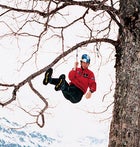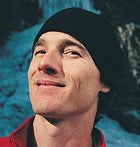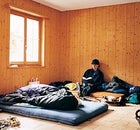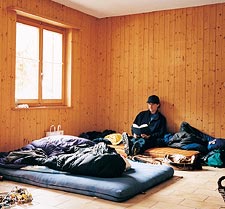ON A WINDY, OVERCAST afternoon, Will Gadd—his auburn hair tousled, his head throbbing from a night of partying—grabs a fistful of red limestone with his right hand and hoists himself using a one-arm pull-up. He plants his shoe on a mere wrinkle in the rock, then reaches skyward for another hold.
 Gadd hanging out at the 2002 Ice Climbing World Cup, Interlaken, Switzerland
Gadd hanging out at the 2002 Ice Climbing World Cup, Interlaken, Switzerland The Danger Boy in Canmore
The Danger Boy in Canmore Gadd in Switzerland, taking a deep-thoughts break from his toys, tools, and toils
Gadd in Switzerland, taking a deep-thoughts break from his toys, tools, and toils
A dual citizen of the United States and Canada, Gadd, 35, is one of the best climbers in the world, especially on ice—but “climbing” doesn’t adequately describe what I’m watching. At 5-foot-11 and 165 pounds, Gadd is a lanky-but-nimble supersimian with a muscled back that curves like a cobra’s hood. In essence he’s an acrobat, and just now, moving without protection, he’s crawling out to the underside of a rude overhang. He looks up at 600 feet of smooth rock, and then works his way back to solid ground to regroup and start again.
“Dude, this is rad!” he says. “Definitely my next major project!”
It’s an autumn day in the Canadian Rockies. Gadd is scrabbling around on Kid Goat Peak, about 50 miles west of Calgary, exploring a towering vertical streak left behind by a long-defunct waterfall. He spotted this route a few weeks ago from his pickup as he whizzed down the Trans-Canada Highway near his home in Canmore, Alberta. That night, Gadd scribbled “CLIMB WATER MARK” on his to-do list, following older entries like “PARAGLIDE ACROSS AMERICA” (which he did last summer) and “CLIMB 6,000-FOOT FROZEN WATERFALL IN NEPAL” (coming soon).
Canmore, a 10,500-person town in the middle of the Canadian Rockies, is prime habitat for funhogs, surrounded by world-class climbing crags, steep kayaking streams, and bright blue skies with rising thermals that can be ridden for hours on paragliders, hybrid craft that combine elements of parachutes and hang-gliders. Gadd climbs, kayaks, and paraglides at an elite level; he also caves, telemarks, and does just about anything else you can think of. But perhaps his most impressive talent—one shared by few of his extreme-sports colleagues—is his knack for, and love of, business. Gadd sells himself with the same intensity he throws at a wall, and his drive to succeed has given him the freedom to pursue his warped idea of fun while getting paid to do it. But he also serves as an object lesson for those of us who think a guy like him has it made.
That’s because being chairman, CEO, and sole employee of the Will Gadd Biz involves a huge amount of work, hustle, headache, and hazard for the money. An athlete who plays baseball as well as Gadd plays risk sports would pull down 20 times what he makes—without the very real possibility of getting killed every time he suits up. Elite mountaineers like Ed Viesturs and Conrad Anker earn twice what Gadd does, mainly because their primary pursuit, expedition climbing in the Himalayas and other remote ranges, is more marketable to sponsors than Gadd’s relatively obscure feats.
So for a talented toiler like Gadd, it’s necessary to be a wheeler-dealer and to capitalize on every ounce of his ability. His annual gross is in the low six figures, most of it coming from endorsement deals with the climbing-equipment company Black Diamond, the Italian ski- and mountaineering-boot company Scarpa, the energy-drink company Red Bull and Voilé, which makes backcountry-ski accessories. He certainly earns it: climbing increasingly difficult routes up rock and ice, winning bouldering and ice-climbing competitions against guys barely half his age, and sticking his neck out with ever-riskier stunts. One example: last year’s record-setting paraglider flight across the continental United States, from Ventura, California, to Kitty Hawk, North Carolina, a six-week, 2,800-mile blitz in which Gadd and a team flew conventional paragliders while wearing large, motorized propellers strapped to their backs.
On the home front, Gadd’s harried existence is made more harried by the presence of his charming but intense girlfriend, 34-year-old Kim Csizmazia, an equally strong-willed multisporter who competes with him for sponsorship bucks, running her own small business out of their Canmore condo.
“Dude. Wanna learn how to run downhill?”
It’s Gadd, stepping off the wall, popping a piece of Nicorette gum as he starts to lope away. I take after him in a hopeless attempt to keep pace. Half running, half sliding, he flies down the mountain, weaving in and out of scrub juniper. By the time I catch up, he has stopped in a leafy clearing, where we see a strange sight: an abandoned log cabin, shimmering in the afternoon sun.
“Is anybody home?” Gadd says to the dilapidated house. “Creepy, eh?”
He pushes open the door and wades through toppled furniture, old pots and pans, and hundreds of yellow, musty books. I see Louis L’Amour novels, Maharishi Mahesh Yogi’s Transcendental Meditation, and the French S&M classic Story of O. Gadd picks up a three-ring notebook and reads aloud from a letter that was never sent, apparently written by the cabin’s stress-addled occupant and addressed to a woman who cheated on him. “You’ll never get away from me,” he warns. “You’ll always be in my sight.”
“Dude! This guy went sideways,” says Gadd. “Check this out. He’s got a to-do list!” With a spiderweb covering his head like a hair net, Gadd clears his throat and reads the itemized goals. “One: Burn camp. Two: Make money. Three: Go to Canmore.”
“Jeez,” he shudders. “This dude needed some serious discipline.”
ONE OF GADD’S favorite ways to do business is over a plate of huevos rancheros at Canmore’s Summit Cafe, the financial section of the Calgary Herald spread out before him, a large coffee in his grasp.
He owns two companies: Gravsports Inc. and WG Sports Research Inc. The first is his channel for product endorsements, prize money from climbing competitions, and story fees for first-person articles and opinion pieces he writes for magazines like Rock & Ice. The other is a white-collar endeavor through which companies like Nike and Simms pay Gadd consulting fees.
Gadd has also been instrumental in expanding the adventure marketplace: In the late 1990s he helped transform the small-time sport of mixed climbing into the fairly hot commodity it is today, largely through his own radical climbs on previously unthinkable routes and his subsequent hectoring of gearmakers to hop aboard with new products.
Based on the style used by climbers for a century to ascend ice-covered peaks with ice axes, modern mixed climbing is much more dangerous. Mixed climbers use their axes to climb inverted frozen waterfalls—with their huge, potentially deadly ice stalactites—and the often crumbly rock surrounding them. To do it right, you need the skill, nerve, and strength of a conventional ice climber and the gymnastic agility of a sport climber.
Back in 1995, you couldn’t buy mixed- climbing-specific equipment and apparel. These days, companies like Grivel, Charlet Moser, and Black Diamond devote product lines to the fast-growing sport, which Gadd has dominated. His participation brought credibility to the X Games ice-climbing competition, a mixed-climbing event, and the Ice Climbing World Cup, a five-event mixed-climbing series held in Europe, which he won during the inaugural 2000 season.
Gadd’s success has a downside: He’s become something of a target for fellow athletes who see him as a crass self-promoter who has robbed mixed climbing of its early purity. Climber Mark Twight is fond of Gadd, but has publicly lambasted him for helping hype the X Games (Twight finds them tasteless) and for drilling bolts for added protection on mixed routes that would otherwise be too dangerous to attempt. “It’s like climbing Everest with oxygen,” snorts Twight. And while modern climbers are realistic about the need to earn a living, Gadd’s style is resented—some see him as a money-grubber.
“Most people land an endorsement deal and then basically just climb,” says Michael Kennedy, former publisher and editor of Climbing magazine, where Gadd worked briefly as an intern in 1989. “Will approaches sponsorship like a little CEO, spending a great deal of time scheming ways that he can add value for his sponsor, market himself better, and do endless hours of promotional work. The result is a sort of media-driven, commercial brand of climbing. And of course it rubs people the wrong way. They get incensed.”
“He’s the most competitive person alive,” says Gadd’s younger brother, Toby, 32, a recreational climber who for several years barely spoke to Will after spending his youth serving as big bro’s personal punching bag. “He’s great at psychological warfare, too. If he gets too old to do what he’s doing now, the business world better look out.”
He’s also a hothead, says Stevie Haston, a British climber and Gadd’s archrival in mixed climbing. Gadd and Haston have had a few heated public exchanges that, Haston says, “occasionally” got physical. “One of the things that’s not so pleasant about him is that he gets right in your face, shouts at judges, and swears at them.”
Gadd is unfazed. He admits to behaving poorly at a World Cup event a few years ago, barking at a judge and almost getting in a fistfight. But he shrugs off Haston’s comments as the rants of an unstable mind—”Reality has never been an impediment in Stevie’s world”—and he has no time for people who think their way of pursuing adventure is morally superior. In a recent article in the American Alpine Journal, Gadd wrote: “Those who deride media-supported climbing trips are usually either jealous or trying to stay true to some sort of historical myth that climbing didn’t used to be commercial.”
“Climbing is exploration,” he concluded. “Exploration costs money.” Everest expeditioners George Mallory and Andrew Irvine, he’ll remind you, didn’t go to the Himalayas on money they made waiting tables. Instead they sold stories to newspapers back home.
GADD’S FAVORITE philosopher is the iron maiden of no-apologies capitalism, Ayn Rand, whose novels Atlas Shrugged and The Fountainhead celebrate the ennobling power of greed. (“I skip the story,” he says, “and read the long monologues.”) To put it mildly, Gadd wasn’t supposed to turn out this way. His father, Ben, was a crunchy socialist from Colorado who moved to Calgary during the Vietnam War, eventually settling in the scenic mountain burg of Jasper. A strict ethicist, he encouraged his sons to be self-reliant and to question authority, which backfired when he drew the line on young Will’s burgeoning instinct to make money.
“I wasn’t even able to have a lemonade stand if my goal was to turn a profit,” Gadd laments.
From his dad, Will learned how to climb and ski almost as soon as he could walk, and at age eight he climbed his first peak, 11,453-foot Mount Athabasca, in the Canadian Rockies. At 16, Gadd was shipped off to the White Mountain School, an outdoorsy prep academy in Bethlehem, New Hampshire, where he stood out as a precocious rebel. “When he showed up, he was already this completely formed little man—a total freak,” says Wendy May, a former dorm adviser at the school. “The other boys didn’t know what to think of him. He argued politics, could climb 5.13—and he even had a girlfriend. Wow, now that was big.”
Gadd went on to Colorado College in Colorado Springs, graduating in 1989 with a degree in political science and taking an internship at Climbing. More accurately, he created the internship. (“They’d never had an intern,” he says, “but I explained what one was and they hired me.”) After three months he felt deskbound, went back to school for a semester, and then moved into his truck and climbed throughout North America for a year, subsisting mostly on popcorn and rice cakes.
About that time he met Dale Goddard, a Boulder-based climber whom Gadd only half-jokingly dubbed his “messiah,” because he taught him both the science and art of climbing. In 1991 Gadd made climbing his job, joining the World Cup sport-climbing circuit. He “won some and lost some,” he says, and managed to become the four-time Canadian national champion, earning about $10,000 a year over four years.
But the rice cakes got old, and by 1994 Gadd had quit sport climbing cold turkey, moved to Boulder, gotten married to a climber named Susy Levin, and taken a desk job doing marketing for a small climbing-gear company. He spent his leisure hours kayaking and paragliding, a new danger sport that caught his fancy. He notched several first descents on Colorado rivers, paddling down steep, low-volume streams and flinging himself off waterfalls. A friend quipped that Gadd was “a 911 call waiting to happen.”
Then came his 30th birthday—and a pre-midlife crisis that prompted Gadd to brood about financial security. “I got scared,” he says. “I didn’t want to spend the rest of my life as a cog in the machine.” He split from Levin and fell in love again—this time with mixed climbing. Working with ice-climbers Jeff Lowe and Helgi Christenson, he took on a 110-foot frozen waterfall near Vail that looked like an upside-down wedding cake made of ice. Nobody had ever tried anything remotely as difficult: The route featured massive ice tendrils with daggers coming down like chandeliers, all surrounded by crumbly limestone. Gadd and Lowe pulled off the climb, rated it M-9 (the hardest rating in mixed climbing at the time), and named it Amphibian—because it was neither rock nor ice, but something new altogether.
In 1998 Gadd traveled to Iceland to make a documentary about his quest for the hardest mixed route on earth. He found it in a 200-foot monster he called Brennivin. On that trip he got to know Csizmazia, arguably the best female ice climber in the world. She was as multitalented as Gadd, having been a ski racer, mountain-bike racer, adventure racer, and superb climber with a reputation for taking on risky pitches. Though petite, she was a physical powerhouse with a bodybuilder’s musculature. Gadd fell for her, and soon after they left Iceland, they were a couple.
“WOULD YOU WANT her coming after you?” Gadd asks me, holding a plate of raw chicken parts. “Do you think you could take her on?”
It’s seven o’clock on a Thursday night; Gadd and Csizmazia are making barbecued chicken and corn on the cob. He’s referring to Csizmazia’s reputation for being a badass—and no, I don’t think I could take her on. A famous tale makes the rounds among climbers that, at an event in Saas-Fee, Switzerland, during the 2000 Ice Climbing World Cup, she, not Gadd, walloped a former judge who was heckling Gadd.
Did it happen? “Yeah, I nailed him,” Csizmazia tells me, carrying salad to the dinner table. She turns to Gadd and busts his chops about his cooking technique. “You’re going to use that?” she says, pointing at a bottle of barbecue sauce that’s past its expiration date.
“Why not?” Gadd says. “It’ll just burn off anyway.”
Their relationship is a bit lunatic. Csizmazia is also sponsored by Black Diamond, among other companies, and she makes a living working as a climbing instructor and endorsing products. Since Will and Kim pursue the same line of work at the same level of intensity, their egos are always battling for supremacy.
“You heard Gadd has an ego?” she asked me facetiously one night. “You’re kidding! Egotistical? Never.”
Last summer, during Gadd’s six-week paragliding trip across the country, their low-simmer love feud boiled over. During a routine paraglide landing in Canmore before the cross-country trip started, Csizmazia tore ligaments in her knee. The injury relegated her to riding shotgun and grazing on Cheetos in the chase car for the next six weeks. Feeling like a caged lioness in a traveling circus of men, she made it obvious that she was having a lousy time, frequently giving the rest of the team, including Gadd, the silent treatment.
Gadd was grumpy himself—he was annoyed with the paragliding motors, which constantly broke down, and he thought a few of his half-dozen teammates behaved like whiny amateurs. The result was a sort of snobby petulance on his part that pissed off other teammates. On the final 60-mile leg, from Rocky Mount to Kitty Hawk, Gadd made the mistake of radioing down and saying he was bushed, that he’d really like to stop for the day.
This was not what Csizmazia, desperate for the whole thing to end, wanted to hear, so she let Gadd know in no uncertain terms that he was being a wimp.
“Will,” she radioed back, “I really think you should finish this thing right now!” Gadd didn’t argue. He flew on to the final destination—the Wright Brothers Memorial on the Outer Banks.
WITHOUT ROPING UP, Gadd scales a 30-foot limestone slab in one of his favorite climbing spots: Grotto Canyon, a steep-walled drainage about ten miles up-valley from Kid Goat Peak. Csizmazia follows, nonchalantly, and the two move across the canyon to a different, harder route. She prepares to lead and Gadd nods coolly that he’s ready to belay.
While she starts up, linking evenly paced moves, Gadd sidesteps a question: How much longer can he play the adventure game without getting seriously injured—or worse?
“I expected I’d already be dead before age 35,” he says matter-of-factly, adding that, by his count, he’s lost 15 friends in the business, and Kim has lost four. Most of these were violent deaths, involving things like mountainside paraglider crashes and fractured skulls.
He acknowledges that premature death would, among other things, be “bad for business,” and he asserts rather dubiously that he isn’t really a risk taker at heart. “You die, you lose,” he says. “This is such a strange business, in that the stakes are so high yet the financial reward is so low for everyone involved. It fucks things up and creates a lot of tribal tension between different adventure sports and different athletes.”
His love of Ayn Rand notwithstanding, Gadd says he would never do anything life-threatening just for the money. He insists he’s trying to do fewer high-adrenaline, high-danger exploits. “For instance, I want to make longer expeditions into parts of the world that I think are culturally interesting, and stay there a while learning about the people.”
But his friends doubt he’ll ever be so laid-back. Consider his datebook for the coming year. This spring he and climber J. P. Vellemare will hike 30 miles across Baffin Island to a mixed climb of the northwest face of Thor, an unconquered 3,000-foot slab of granite. Then they’ll kayak back to where they started. In September, assuming Nepal’s political conditions permit, Gadd will go there to climb a 6,000-foot frozen waterfall, twice as tall as any ice climb ever attempted. He’ll also try to set a new paragliding altitude record by flying above 22,000 feet.
“Will? Are you paying attention?” It’s Csizmazia, calling down to her belayer.
Gadd checks the tension on his belay. “I got you,” he yells back, and then turns to me and resumes chatting.
Another wavering voice from above. “Will? I’m gonna fall.”
We look up. Csizmazia has climbed well beyond her protection, and she looks to be trapped without options. She grips the wall with her fingers, trying to avoid a 20-foot tumble. “Oh, God,” she says. “What do I do?”
Gadd tries to soothe her. “No problem, Kim. You’re gonna be OK. Just figure out what you’re going to do next. You see that big handhold just above your left hand? Go for that, and then stick your right foot in that crack to your right.”
“I just don’t know what to do,” she says. Gadd suddenly loses his temper. “There’s a bolt right above your left hand! Go for it!”
“Will. I’m going to fall.”
“No, you’re not!” he bellows. “Just get ahold of yourself and climb!”
Which Csizmazia does. She makes two tricky moves, and then clips into the bolt above her.
“Now move your hand up and to the left,” Gadd says. And suddenly the worst is over. With a total of four moves, she’s standing at the top. He eases her back down by slowly letting out the rope.
“It’s the kind of freak-out that can happen to anyone,” Gadd says to me when she’s back on solid ground. “I’ve done it, too. But dude,” he says, “you should see her on the ice!”
He pops a piece of Nicorette, and the banter begins. “That’s a stupid habit,” Csizmazia says, making a sour face.
“Hey, I didn’t puke on you,” he fires back, employing a figure of speech that only they know about.
“I didn’t puke on you, either,” Csizmazia says. Then they hold hands and giggle. Feud over.


